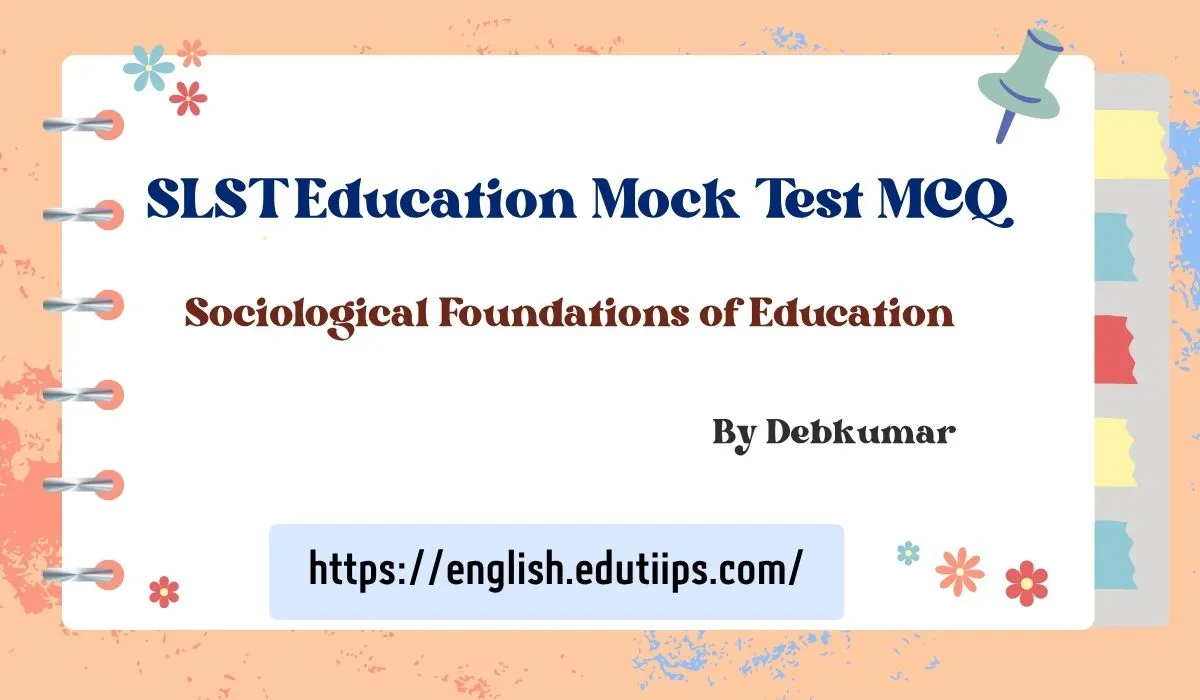Practice SLST Education Mock Test MCQ on Sociological Foundations of Education with handpicked MCQs. Strengthen your preparation with topic-wise questions for SLST & other teaching exams.
SLST Education Mock Test MCQ | Sociological Foundations of Education MCQ Practice
If you’re preparing for WBSSC SLST (School Level Selection Test) under the subject Education, mastering the Sociological Foundations of Education is essential. This topic explores how education interacts with society, social institutions, culture, and social change.
In this mock test, you’ll find multiple-choice questions (SLST Education Mock Test MCQs) based on the latest SLST exam pattern. These questions are carefully curated to test your conceptual clarity, theoretical understanding, and practical application of educational sociology.
Sociological Foundations of Education Syllabus
III. Sociological Foundations of Education
- Social Groups – Primary Group and Secondary Group
- Social Processes –Associative and Dissociative.
- Education, Society and Social Change.
- Education and Socialization.
- Current sociological Problems of Education in India – Illiteracy and Universalization of Primary Education Equality of Educational Opportunity
- Education of SC, ST and OBC.
Q. Which of the following is an example of a primary group?
A) Political party
B) Trade union
C) Family
D) Corporation
Q. Who introduced the concept of primary and secondary groups?
A) Max Weber
B) Emile Durkheim
C) Charles H. Cooley
D) Karl Marx
Q. What is the main characteristic of a secondary group?
A) Emotional intimacy
B) Long-term relationship
C) Goal-oriented interaction
D) Face-to-face contact
Q. Which group plays a crucial role in the early socialization of a child?
A) School
B) Peer group
C) Family
D) Office
Q. Which of the following is NOT a characteristic of a primary group?
A) Small size
B) Emotional depth
C) Personal relationships
D) Formal rules
Q. Which group is most likely to be temporary and based on specific interests?
A) Family
B) Friends
C) Sports team
D) Work colleagues
Q. A school classroom is best categorized as a:
A) Primary group
B) Reference group
C) Secondary group
D) Informal group
Q. In which group are roles more formal and defined?
A) Primary group
B) Secondary group
C) Kinship group
D) Informal group
Q. A group where relationships are face-to-face and personal is known as:
A) In-group
B) Out-group
C) Primary group
D) Secondary group
Q. Which of the following is a feature of a secondary group?
A) Small size
B) Emotional closeness
C) Long duration
D) Formal structure
Q. Which of the following groups is based on indirect communication?
A) Family
B) Friends
C) Office staff
D) Childhood playmates
Q. What type of group is a political party?
A) Primary group
B) Peer group
C) Secondary group
D) Pressure group
Q. Which group provides a sense of belonging and identity in early life?
A) Government
B) Peer group
C) Media
D) Family
Q. What distinguishes a primary group from a secondary group the most?
A) Number of members
B) Formality of rules
C) Nature of relationships
D) Duration of existence
Q. Peer groups among teenagers are an example of:
A) Secondary group
B) Tertiary group
C) Primary group
D) Informal organization
Famous Sociologists, Books, and Concepts – (Primary & Secondary Group)
Q. In which book did Charles H. Cooley introduce ‘Primary Group’ and ‘Secondary Group’?
A) Social System
B) Social Organization
C) Human Society
D) Sociology of Groups
Q. What year was the book Social Organization published?
A) 1897
B) 1902
C) 1909
D) 1915
Q. Who is the author of Human Nature and the Social Order?
A) Herbert Spencer
B) Charles H. Cooley
C) Emile Durkheim
D) Talcott Parsons
Q. When was Human Nature and the Social Order published?
A) 1901
B) 1902
C) 1903
D) 1905
Q. Which of the following concepts is associated with Charles H. Cooley?
A) Collective Conscience
B) Bureaucracy
C) Looking-glass self
D) Anomie
Q. What is the main feature of a Primary Group according to Cooley?
A) Formal rules
B) Impersonal relations
C) Emotional intimacy
D) Economic interest
Q. What is the primary purpose of a Secondary Group?
A) Emotional bonding
B) Informal interaction
C) Goal achievement
D) Family support
Q. Which sociologist emphasized the role of small groups in socialization?
A) Karl Marx
B) Charles H. Cooley
C) Herbert Spencer
D) Max Weber
Q. Which book discussed how self-concept is developed through social interaction?
A) The Rules of Sociological Method
B) The Division of Labour
C) Human Nature and the Social Order
D) Society and Personality
Q. The concept “Looking-glass self” means:
A) Self is shaped by biological factors
B) Self develops independently
C) Self is a reflection of others’ perceptions
D) Self is fixed from birth
Q. What type of group did Cooley refer to as essential for developing one’s personality?
A) Religious group
B) Peer group
C) Secondary group
D) Primary group
Q. Which of the following is not a characteristic of primary group as per Cooley?
A) Small size
B) Emotional intimacy
C) Personal contact
D) Goal orientation
Q. What is the core subject of Cooley’s Social Organization?
A) Religion in society
B) Family law
C) Classification of social groups
D) Economy and culture
Q. Which of the following pairs is correctly matched?
A) Max Weber – Social Facts
B) Emile Durkheim – Bureaucracy
C) Charles H. Cooley – Primary Group
D) Karl Marx – Looking-glass self
Conclusion
Sociological Foundations of Education is not only a scoring topic but also helps build a strong conceptual grounding in teaching-learning processes. By practicing topic-wise SLST Education Mock Test MCQs like these, you’re preparing yourself for success in WBSSC SLST, NET, CTET, and other competitive teaching exams.
Keep revising regularly, and test yourself with similar topic-wise quizzes to master all subfields of education
References
- Aggarwal, J. C., Theory and Principles of Education. 13th Ed. Vikas Publishing House Pvt. Ltd.
- V.R. Taneja, Educational Thoughts & Practice. Sterling Publication Pvt. Ltd. New Delhi
- Nayak, B.K, Text Book of Foundation of Education. Cuttack, Odisha: KitabMhal
- Ravi, S. Samuel, A Comprehensive Study of Education, Fourth Printing-May 2016, Delhi – 110092, ISBN – 978-81-203-4182-1,
- SLST Education Mock Test MCQ
- Internet sources
Q – What is the importance of Sociological Foundations in Education?
Ans – It helps understand how social structures, norms, and values impact the education system, teaching-learning, and curriculum development.





